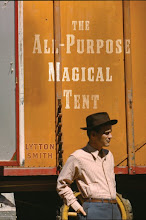

The current issue (5) of A Public Space has a wonderful illustrated guide by Lucy Begg called (Field] Notes on/from a Treehouse [in Texas]. She describes and illustrates in drawings and photographs the building of a steel treehouse in the Lost Pines area of Texas, on a piece of land belonging to Richard Linklater, near Bastrop TX.
Perhaps my favourite part of the guide is the naming of the treehouse Skylark, and the picture of the wonderfully bearded "hand old-school sign painter" Greg Jones.
I loved the name because it seems to sum up the endeavour exactly: a lark in the treetops, up by the sky. There's another reason for the name, though: chief architect Steve Ross suggested it when the Wordsworth poem "To a Skylark" came into his mind during the project. Ross writes to Linklater that "Wordsworth used the skylark as a metaphor for a more 'fully self realized life'" and recalls that Emerson wrote about the poem (Linklater's treehouse ambitions owe a lot to the Transcendentalists).
It's beautiful to think of Wordsworth, that earth-bound poet always walking, walking, walking, but with his gaze so often to the air, christening an aerial space that collapses sky and ground, a platform 21 feet up in the air around which the tree can continue to grow.
The poem, however, and somewhat pleasingly, isn't Wordsworth's, but was written in Italy in 1820 by Percy Bysshe Shelley. The authorship matters less, I think, that the imaginative possibilities a mis-remembered line suggested to a group working in the woods, eating tacos cooked on off-cut steel sheeting, hauling a structure into the air. But the poem's worth reading, not least because it contains the fabulous address "thou scorner of the ground." I've posted it separately below.
Picture is of the oldest treehouse in the world, a Gothic design at Pitchford Hall Estate, United Kingdom. If anyone has pictures of Linklater's treehouse, let me know.

1 comment:
Heello mate great blog post
Post a Comment